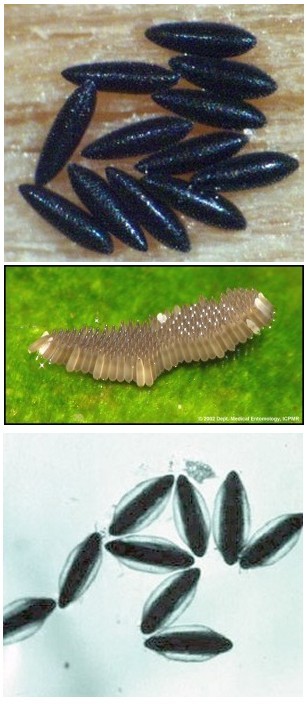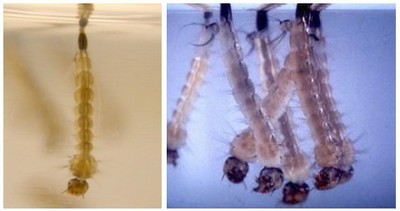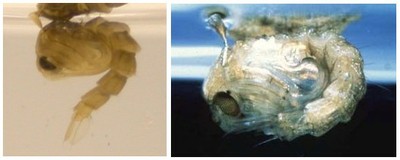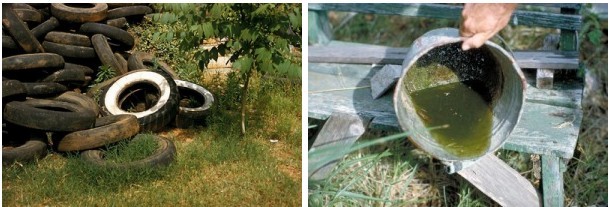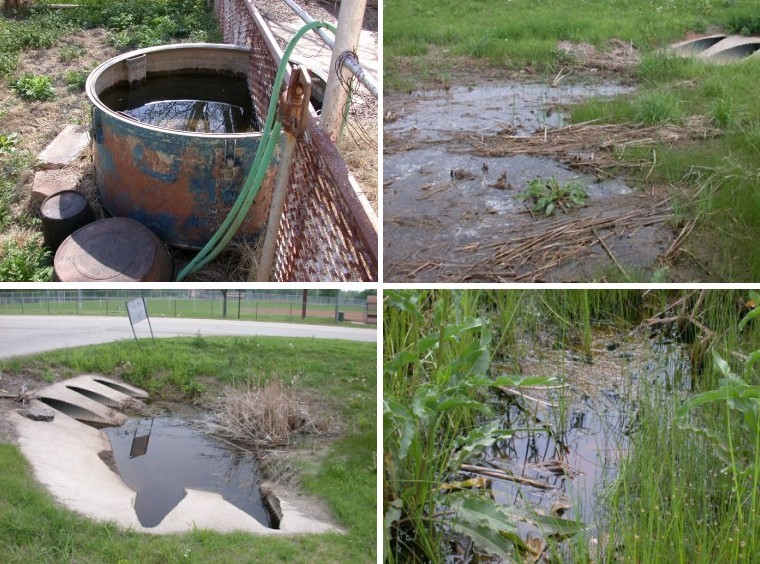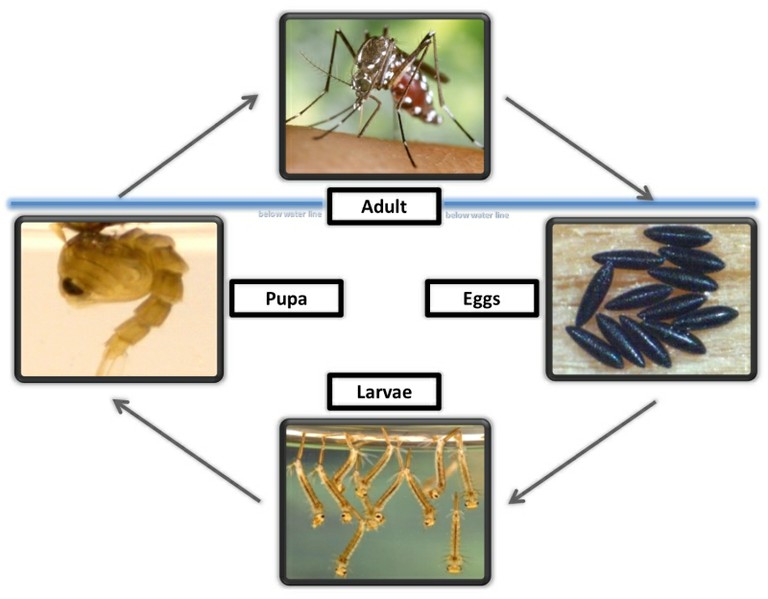Mosquitoes
Introduction
Over 60 mosquito species occur seasonally in Oklahoma - from March through first frost in November. A few early species prefer cool weather, but the majority of adult mosquitoes are pests during April, May, and June, especially following spring rains. Culiseta mosquitoes first become active in Oklahoma in March with subsequent summer species usually appearing in April and May. Mosquitoes may be present even after the first frost because emerging larval and pupal populations may not be affected by a light freeze. Mosquito populations in Oklahoma are greatly influenced by the weather. Scattered rains may lead to higher populations of mosquitoes in certain areas and not in others. During hot, dry summers there normally are not enough mosquitoes present to cause pest problems.
General Information
Biology
The mosquito has four distinct stages in its life cycle: egg, larva, pupa, and adult. The adult is an active flying insect, while the larvae and pupae are aquatic and occur only in water. Depending on the species, eggs are laid either on the surface of water or are deposited on moist soil or other objects that will often be flooded.
Principal Characters for Identifying Aedes, Anopheles, and Culex
Eggs
One factor common to all mosquito species is that eggs are laid in association with free water or on a moist surface. Eggs are white when first deposited, darkening to a black or dark brown within 12-24 hours. Single eggs are about 1/50 inch (0.5mm) long, and those of most species appear similar when seen by the naked eye (one exception is the Anopheles spp. whose eggs have floats attached to each side of the egg). Eggs are laid singly by some species, and others lay eggs together to form rafts. The incubation period (time between when eggs are laid and when they hatch) may vary considerably among species. Eggs of permanent-water mosquitoes where eggs are deposited on the water surface may hatch in 1-3 days depending on temperature. Floodwater species deposit their eggs on moist soil or another wet substrate and have a wide variation in incubation periods. These eggs will not hatch until submerged by rising water caused by rainfall, melting snow in the spring, or other floodwater. Depending on the species and conditions these eggs may hatch the next time they are flooded, as soon as ten days, or may not hatch until they are flooded a year or more later.
Aedes albopictus (top), Culex spp. (middle), Anopheles spp. (bottom)
Larvae
The larvae (wigglers or wrigglers) of all mosquitoes live in water and have four developmental periods or instars. These are called 1st, 2nd, 3rd, and 4th instars with each succeeding stage larger than the last. At the end of each instar, the larva sheds its skin by a process called molting. The larva is an active feeding stage. Larvae feed on particulate organic material in the water. The larvae of most species have a breathing tube and must occasionally come to the surface of the water to get oxygen. The total length of time that larvae spend in the larval stage depends on the species and the water temperature. Some can develop in as little as 5 or 6 days. Upon maturity the 4th instar larvae molts into the pupal stage.
Aedes albopictus (left),
Culex spp.(right)
Pupae
Unlike most other insects, the mosquito pupa is very active, and, like the larva, lives in water. It differs greatly from the larva in shape and appearance. The pupa has a comma-shaped body divisible into two distinct regions. The front region consists of the head and thorax (cephalothorax) and is greatly enlarged. It bears a pair of respiratory trumpets on the upper surface. It must periodically come to the surface to get oxygen. The second region is the abdomen which has freely-movable segments with a pair of paddle-like appendages at the tip. Feeding does not take place during the pupal stage. The pupal stage only lasts for a few days and is the stage when all the larval tissues change into the adult tissues. The adult emerges directly from the pupal case on the surface of the water.
Aedes albopictus (left),
Anopheles spp. (right)
Adult
The adult mosquito is entirely terrestrial and is capable of flying long distances. Both females and males feed on nectars which they use for energy. Males and females mate during the first 3 to 5 days after they have emerged. Females mate only once. Males generally live for only a week. Only the females feed on blood, which is what is occurring when they are biting. Females evidently gain little nourishment from blood meals but need them in order to develop eggs. Many mosquitoes feed on any warm-blooded bird or mammal. However, some prefer cold-blooded animals. Some species also prefer birds and seldom feed on mammals, which is the case with Culex spp. mosquitoes which are known to transmit the West Nile virus (WNV). Unfortunately many species feed on a wide range of warm-blooded mammals and humans are often attacked. Once a female has completely engorged she flies to a shaded environment until her eggs are completely developed, usually 3 to 5 days. Once the eggs are developed the female is called a gravid female and she begins to search for a desirable place to lay her eggs. If a female survives her egg laying activities, she will very soon start searching for another blood meal after which she will lay another batch of eggs. She does not need to mate a second time. Generally a female will only live long enough to lay 1 to 3 batches of eggs.
Most mosquito species are actively searching for a blood meal in the evening hours from just before dark until 2 to 3 hours after dark. During the daytime the females normally rest in cooler vegetated areas where the humidity is higher and they are protected from drying out. Females will often bite in the daytime if humans or animals invade the wooded areas where they are resting. However, Aedes albopictus is an aggressive biter which prefers to feed during the daylight hours and is often a nuisance in urban areas.
Aedes albopictus female (left), Aedes albopictus male (right)
Aedes albopictus, Asian Tiger Mosquito (left), Culex quinquefasciatus, Southern House Mosquito (right)
Steps for Effective Mosquito Control
Education
One of the most effective tools available is awareness of mosquito biology so that
you can eliminate future mosquito breeding sites from your yard. You should be aware
of the life cycle of mosquitoes so you can take steps to avoid rearing mosquito larvae
in water containers on your property. You should eliminate larval breeding sites such
as discarded tires, beverage cups/litter, and unused children's wading pools. Residents
should clean and replenish pet water and bird bathes every 3 days, clean roof gutters
to allow proper drainage, prevent standing water in flower pots, ensure good property
drainage, and plug hollow tree stumps. Water gardens or small fountains should be
treated with larvicides or contain mosquito eating fish to prevent emerging adult
mosquitoes. Maintenance of screen doors and windows will prevent adult mosquitoes
from entering homes. Remember, any container that will hold water for 5 to 7 days
is a potential breeding site for mosquito larvae.
Source Reduction of Larval Habitats
One of the simplest ways to reduce larval mosquito populations is to drain any unnecessary
containers/pools of water which allow mosquito larval development. If it is not possible
to drain areas, then treating them with larvicides if they are supporting larvae is
an alternative. Many mosquito larvicides on the market are very host specific and
only disrupt the larval stages of mosquitoes and do not harm non-target species.
Personal Protection
People can reduce their exposure to biting mosquitoes by wearing insect repellent when they are outdoors. They can also avoid being outside at dawn, early evening, and dusk when the majority of biting female mosquitoes are active. Wearing long sleeved clothing with long pants also provides protection. Repellants which contain from 10 to 30% DEET (N, N diethyl-m-toluamide) are most effective, but always read and follow label directions for proper application. Special care should be taken when applying repellants to children. Click here for some frequently asked questions about insect repellent use.
Insect Repellent Use
Using repellents on the skin is not the only way to avoid mosquito bites. Children and adults can wear clothing with long pants and long sleeves while outdoors. DEET or other repellents such as permethrin can also be applied to clothing (don't use permethrin on skin), as mosquitoes may bite through thin fabric. Mosquito netting can be used over infant carriers. The following are some questions that may be raised concerninf the use of insect repellents.
- Why should I use insect repellent?
Insect repellents help people reduce their exposure to mosquito bites that may carry potentially serious viruses such as West Nile virus, and allow them to continue to play and work outdoors.
- When should I use mosquito repellent?Apply repellent when you are going to be outdoors and will be at risk for getting bitten by mosquitoes.
- What time of day should I wear mosquito repellent?Many of the mosquitoes that carry the West Nile virus are especially likely to bite around dusk and dawn. If you are outdoors around these times of the day, it is important to apply repellent. In many parts of the country, there are mosquitoes that also bite during the day, and these mosquitoes have also been found to carry the West Nile virus. The safest decision is to apply repellent whenever you are outdoors.
- How often should repellent be reapplied?Follow the directions on the product you are using in order to determine how frequently you need to reapply repellent. Sweating, perspiration or getting wet may mean that you need to re-apply repellent more frequently. If you are not being bitten, it is not necessary to re-apply repellent. Repellents containing a higher concentration of active ingredient (such as DEET) provide longer-lasting protection.
- How does mosquito repellent work?Female mosquitoes bite people and animals because they need the protein found in blood to help develop their eggs. Mosquitoes are attracted to people by skin odors and carbon dioxide from breath. Many repellents contain a chemical, N,N-diethyl-m-toluamide (DEET), which repels the mosquito, making the person unattractive for feeding. DEET does not kill mosquitoes; it just makes them unable to locate us. Repellents are effective only at short distances from the treated surface, so you may still see mosquitoes flying nearby. As long as you are not getting bitten, there is no reason to apply more DEET.
- Which mosquito repellent works the best?The most effective repellents contain DEET (N,N-diethyl-m-toluamide), which is an ingredient used to repel pests like mosquitoes and ticks. DEET has been tested against a variety of biting insects and has been shown to be very effective. The more DEET a repellent contains the longer time it can protect you from mosquito bites. A higher percentage of DEET in a repellent does not mean that your protection is better?just that it will last longer. DEET concentrations higher than 50% do not increase the length of protection.
- How does the percentage of DEET in a product relate to the amount of protection it
gives?
Based on a recent study:
- A product containing 23.8% DEET provided an average of 5 hours of protection from mosquito bites
- A product containing 20% DEET provided almost 4 hours of protection
- A product with 6.65% DEET provided almost 2 hours of protection
- Products with 4.75% DEET and 2% soybean oil were both able to provide roughly 1 and a half hour of protection
Choose a repellent that provides protection for the amount of time that you will be outdoors. A higher percentage of DEET should be used if you will be outdoors for several hours while a lower percentage of DEET can be used if time outdoors will be limited. You can also re-apply a product if you are outdoors for a longer time than expected and start to be bitten by mosquitoes.
- Are non-DEET repellents effective (e.g. Skin-So-Soft, plant-based repellents)?Some non-DEET repellent products which are intended to be applied directly to skin also provide some protection from mosquito bites. However, studies have suggested that other products do not offer the same level of protection, or that protection does not last as long as products containing DEET. A soybean-oil-based product has been shown to provide protection for a period of time similar to a product with a low concentration of DEET (4.75%). People should choose a repellent that they will be likely to use consistently and that will provide sufficient protection for the amount of time that they will be spending outdoors. Product labels often indicate the length of time that protection that can be expected from a product. Persons who are concerned about using DEET may wish to consult their health care provider for advice. The National Pesticide Information Center (NPIC) can also provide information through a toll-free number, 1-800-858-7378 or http://npic.orst.edu/.
- What are some general considerations to remember in order to use products containing
DEET safely?
Always follow the recommendations appearing on the product label.
- Use enough repellent to cover exposed skin or clothing. Don't apply repellent to skin that is under clothing. Heavy application is not necessary to achieve protection.
- Do not apply repellent to cuts, wounds, or irritated skin.
- After returning indoors, wash treated skin with soap and water.
- Do not spray aerosol or pump products in enclosed areas.
- Do not apply aerosol or pump products directly to your face. Spray your hands and then rub them carefully over the face, avoiding eyes and mouth.
- How should products containing DEET be used on children?
No definitive studies exist in the scientific literature about what concentration of DEET is safe for children. No serious illness has arisen from use of DEET when used according the manufacturer's recommendations. The American Academy of Pediatrics has recommended that a cautious approach is to use products with a low concentration of DEET, 10% or less, on children aged 2 - 12. Most guidelines cite that it is acceptable to use repellents containing DEET on children over 2 years of age. Other experts suggest that it is acceptable to apply repellent with low concentrations of DEET to infants over 2 months old. Repellent products that do not contain DEET are not likely to offer the same degree of protection from mosquito bites as products containing DEET. Non-DEET repellents have not necessarily been as thoroughly studied as DEET, and may not be safer for use on children.
- Parents should choose the type and concentration of repellent to be used by taking into account the amount of time that a child will be outdoors, exposure to mosquitoes, and the risk of mosquito-transmitted disease in the area. Persons who are concerned about using DEET or other products on children may wish to consult their health care provider for advice. The National Pesticide Information Center (NPIC) can also provide information through a toll-free number, 1-800-858-7378 or http://npic.orst.edu .
- Always follow the recommendations appearing on the product label when using repellent.
- When using repellent on a child, apply it to your own hands and then rub them on your child. Avoid children's eyes and mouth and use it sparingly around their ears.
- Do not apply repellent to children's hands. (Children tend to put their hands in their mouths.)
- Do not allow young children to apply insect repellent to themselves; have an adult do it for them. Keep repellents out of reach of children.
- Do not apply repellent to skin under clothing. If repellent is applied to clothing, wash treated clothing before wearing again.
Chemical Control for Adult Mosquitoes
Homeowner chemical control for adult mosquitoes is not practical and decisions regarding control should be left up to municipal regulation. Area wide chemical control for adult mosquitoes in Oklahoma is typically applied by thermal fogging or Ultra Low Volume (ULV) spraying. This type of control is not usually effective in Oklahoma because it is very rare for conditions to be conducive for fogging adult mosquitoes. Adult mosquitoes must come into contact with the pesticide, so timing of application is critical. Since different mosquito species are active during different periods throughout a 24hr day it is critical to fog at exactly the proper time to get effective control of the target species. Extensive behavioral knowledge of the species to be controlled must be utilized and the spray applied only when adults are active. Weather conditions must be considered, as windy conditions usually present in the spring in Oklahoma may cause pesticides to drift out of an area so that they never reach their intended target. If ULV spraying is utilized the air temperature should be at least 60oF, with wind velocities between 3-5 mph. Spraying in the heat of the day is not recommended as ULV droplets volatilize and go upward out of target areas. ULV spray equipment must be properly calibrated and operated by experienced personnel to ensure proper pesticide application rates. Pesticide label rates and recommendations must be followed according to the manufacturers instructions for all pesticides applied. Mosquito control products available for consumer use are typically sold through local home and garden supply stores. Product availability may vary according to location and state regulation.
Products Registered for Control of Mosquitoes in Oklahoma
Because of changing product lines and new product registrations, a direct link is now provided to the Oklahoma Department of Agriculture, Food, and Forestry's website listing approved products by category. The information given herein is for educational purposes only. No endorsement of products mentioned is intended nor is criticism implied of products not mentioned.
Chemical Control for Larval Mosquitoes
A listing of approved mosquito larvicides has been developed to aid municipal workers
in treating mosquito populations in storm drains or catch basins in Oklahoma. View
a comprehensive list of these products.
Generalized Mosquito Life Cycle
The mosquito has four distinct stages in its life cycle: egg, larva, pupa, and adult. The adult is an active flying insect, while the larvae and pupae are aquatic and occur only in water. Depending on the species eggs are laid either on the surface of water or are deposited on moist soil or other objects that will often be flooded. One method of classifying mosquitoes, which is important in the control of the larval stage, is by the type of habitat in which the eggs are laid. Those species that lay eggs singly on the moist soil usually near the edge of temporary pools of water are known as flood water mosquitoes. These eggs only hatch after they have been flooded by water. Psorophora, Aedes, and Ochlerotatus mosquitoes are floodwater mosquitoes which are most abundant shortly after spring rainfall. Those species that lay eggs on the surface of the water, either clumped in rafts or as single floating eggs, are known as permanent water mosquitoes. Anopheles, Culiseta, and Culex are permanent water mosquitoes found in Oklahoma. Floodwater mosquitoes are usually pests in April and May in Oklahoma, with permanent water mosquitoes being problems later in the summer.
Medically Important Mosquitoes in Oklahoma
Very few mosquitoes in Oklahoma are able to transmit diseases. Of the 60 plus species present in Oklahoma, only 7 to 10 species are considered medically important because of their pest status to people. Disease transmission by mosquitoes is complex, and being bitten by a mosquito does not mean an individual will develop an illness. If a mosquito-borne disease is detected in Oklahoma the mosquito species transmitting the disease must be identified. Control measures targeting the biology and behavior of that particular species are then implemented to reduce pest populations and prevent further disease transmission.Most likely mosquitoes species (based on relative abundance) present in Oklahoma which could transmit the West Nile Virus: (* Denotes species from which WNV disease isolates have been reported to CDC/Arbonet in 2002.)
- Aedes albopictus*
- Culex pipiens/quinquefasciatus*
- Culex restuans*
- Culex salinarius*
- Culex tarsalis*
- Culiseta inornata*
Other vector species present in the state from which WNV has been isolated:
- Aedes cinereus
- Aedes vexans*
- Anopheles punctipennis*
- Anopheles quadrimaculatus*
- Coquillettidia perturbans*
- Culex nigripalpus
- Culiseta melanura
- Ochlerotatus canadensis
- Ochlerotatus sollicitans*
- Ochlerotatus taeniorhynchus
- Ochlerotatus triseriatus*
- Ochlerotatus trivittatus*
- Psorophora columbiae
- Psorophora ciliata*
No disease isolates have been made as of yet from Aedes aegypti for West Nile Virus. However, this is a medically important species which has transmitted other diseases and should be suspect for WNV transmission in Oklahoma.
Links
- Mosquito Sampling and Techniques - (8.1 MB file size)
- Mosquitoes in Oklahoma - (9.2 MB file size)
- CDC West Nile Virus site
- Oklahoma Mesonet - Current Weather Conditions

